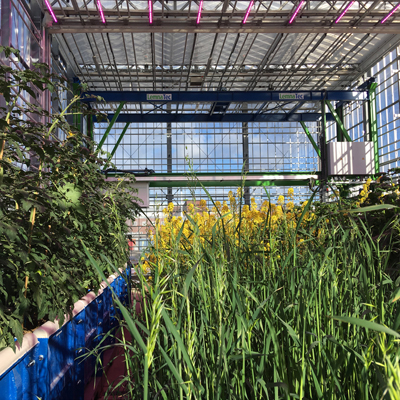Our soil laboratories have state-of-the-art analytical equipment and technical staff with expertise in all widely-recognised techniques to characterise soil physical, chemical and biological properties. These facilities complement our Soil Management Facility, the Wolfson Field Laboratory, and the CHAP and AgriEPI AgriTech Centres.
Our facilities
Soil Physics
- Standard laboratory analyses according to British Standards Institute (BSI) approved methods
- Particle size analysis by laser diffraction and the pipette method
- Particle density by the pycnometer method
- Soil aggregate stability using wet sieving and raindrop impact methods
- Soil bulk density by core and excavation methods
- Soil compaction using digital penetrometers and bulk density rings
- Soil moisture characteristics using pressure plates and sand tables
- Soil water using moisture sensors in the field
- Soil infiltration rates using infiltrometers
- Soil micro-structure by X-ray computed tomography
- Soil shear strength using tor vanes and shear boxes (translational and tri-axial)
- Soil surface roughness using a Micro-Epsilon laser sensor measuring vertical displacement.
Soil Chemistry
- Standard laboratory analyses according to British Standards Institute (BSI) approved methods
- Total elemental analysis by microwave digestion and analysis by Inductively Coupled Plasma-Mass Spectrometry (ICP-MS) and Atomic Absorption Spectrophotometry (AAS)
- Total, organic and inorganic carbon and nitrogen by a CN analyser
- Available nitrogen and phosphorus by standard extractions and colorimetric analysis in segmental flow analysers
- Cation exchange capacity, and exchangeable cations and acidity
- Soil pH, redox potential and dissolved gases by sampling soil solution and analysis using micro-electrodes
- Mid- and near-infra-red spectrometry for analysis of soil mineralogy
- Solute diffusion coefficients in soil by measurement of concentration-distance profiles and mathematical analysis
Soil Biology
- Soil biomass carbon by fumigation-extraction
- Phospholipid fatty acid analysis (PLFA) describes the viable microbial community’s phenotype based on organism-specific membranes biomarkers
- DNA approaches e.g. shotgun metagenomics and amplicon sequencing combined with bioinformatics and advice on eDNA sample preparation, choices of primers and sequencing platforms, sequence quality filtering and interpretation, including taxonomic and functional analysis
- Catabolic response profiles by measuring multiple-substrate induced respiration using the Rapid Automated Bacterial Impedance Technique (RABIT), gas chromatography and colorimetry
- Soil extracellular enzymes by analyzing substrates of the fluorophore 4-methylumbelliferone (4-MUF) complex to assay multiple enzyme activities (e.g. phosphatase, sulfatase, cellobiohydrolase, glucosaminidase)
- Thermal Efficiency by isothermal micro-calorimetry to quantify carbon assimilation and resource use efficiencies in soil
- Macro and mesofauna population estimations using various in-field techniques and laboratory methodologies such as tullgren funnels
Our research
- Improving crop yield through management of soil organisms, 2012-2015 (Defra)
- Wastes and Organic Matter improve Soil Structure, 2012-2016, (AHDB)
- Fundamental Basis of Soil Biological Resilience, 2012-2015 (BBSRC)
- Transatlantic Initiative for Nanotechnology and the Environment, 2010-2014 (NERC)
- Biodiversity and Ecosystem Service Sustainability Programme – BESS Urban: Fragments, functions and flows 2012 – 2017 (NERC)
- Marketable Sludge Derivatives from Sustainable Processing of Wastewater in a Highly Integrated Treatment Plant, 2011-2014 (EU)
- Anaerobic Digestate Application onto Sport Turfs, 2012-2014 (WRAP)
- Enhancing nutrient use efficiency from biosolids for a resilient crop production system, 2016 (NERC)
- Holistic decision-support system for slurry storage and treatment techniques for maximum nutrient use efficiencies, 2016-2018 (SLURRY-MAX) (NERC)
- FOWARIM (FOstering Water Agriculture Reuse In Malta), 2016-2018 (EU Horizon2020 Twinning Project)
- Modelling soil conditions at sugar beet harvest. UK Innovate KTP with British Sugar (2015-2018)
- Cover and companion cropping for soil health in intensive salad rotations Gs Growers (2016-2019)
- Defra project SP1611: Soil Quality Indicators (physical properties) (2011-12)
- Defra project SP1317: How Does A Loss Of Soil Depth Impact On The Ability Of Soils To Deliver Vital Ecosystem Services (2013-2016)
- SOWAP: “Soil and water protection using conservation tillage in northern and central Europe” (EU LIFE project; 2005-08)





















